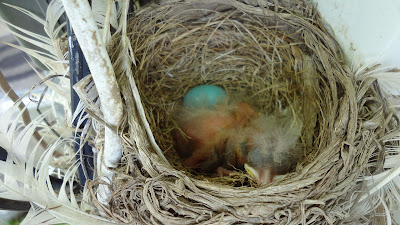The wicked weather we're hearing about these days is nothing new. Here's an account of a vicious storm in Lancaster County, Pennsylvania, on June 17, 1768, which devastated the countryside. This was published in the Pennsylvania Chronicle on June 23, 1768.
"On Friday the 17th inst. about 2 o'clock pm
the sky was overspread with flying clouds, apparently charged with heavy rain.
The wind blew pretty fresh from the southeast and thickened the clouds in the
opposite quarter; so that about 4 o'clock there was darkness visible in the
northwest attended with distant rumbling thunder, and now and then with a small
gleam of lightning, without any explosions. The clouds deepened more and more in
the northwest, and thus seemed to make a stand, being opposed by the wind from
the opposite points. At half-after four, they assumed a frightful appearance,
and at last a large crescent, with its concave sides to the wind and its inner
edges tinged with a dusky violet color. About five the wind veered about to the
northwest, which immediately gave motion to the clouds, and discharged a most
dreadful and destructive volley of hail. The storm then proceeded in a southeast
direction, at the rate of twelve miles an hour, attended with a most dreadful
noise something like the sounds of cannon, drums and bells mingled together.
The hail
stones were of various dimensions, shapes and forms. Some measured nine inches
in circumference, some seven, whilst others were not larger than peas. As to
their forms, some were of globular, some spheroidal, surrounded with smaller
excrescences or knobs, some elliptical, and some irregular and smooth, like
pieces of ice. Such as were globular, were endued with so much elasticity that
they rebounded from the ground like a tennis ball. This storm divided into
several branches, or veins, if I may use such terms, all which kept the same
course, but bent their fury mostly towards the mountains hills and
highlands.
At
Susquehanna the hail was as large as pigeon's eggs; at Lancaster about the size of peas; at
Dunkertown [Ephrata], and in the valley, between the Welsh and Reading hills
[probably means Weaverland Valley], they were as large as turkey's eggs; in some
other places still larger; and at Reading no hail appeared.
The
damage done by this storm is very great; the county of Lancaster alone, it is
thought, has suffered several thousand pounds. In many places there is not a
single ear of wheat, rye, barley, etc. but what is cut off; and nothing left but
the green straw, bruised and beat to pieces. It is melancholy to see fine
plantations, and extensive fields, which a few days ago waved with luxuriant
crops, now lying waste. Many able farmers who expected to carry several hundred
bushels of grain to market will be obliged to buy bread for their families and
many of the poorer kind will be ruined, and reduced to beggary. All these people
are mowing their late promising and rich crops as fodder for their cattle. Their
distress is moving and alarming.
At
Dunkertown, it is said, with what truth I cannot say, that cattle were killed by
the hail; but certain it is, that about Muddy Creek [Bowmansville], in this county, calves,
pigs, fowls, etc. were killed in that settlement; ground in the woods is as
thick covered with green foliage, beaten from the trees, as it is with the
fallen leaves in the month of October; and in many places the birds are found
dead in woods and orchards. The northwest side of the fruit trees are barked,
and all the glass windows on that side, that were not secured by shutters, are
demolished; and even the rails of the fences, visibly show the impression of
hail upon them. In short, this storm threw every person who saw it into the most
dreadful consternation; for the oldest man here never saw or heard anything like
it."





